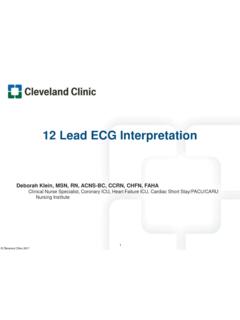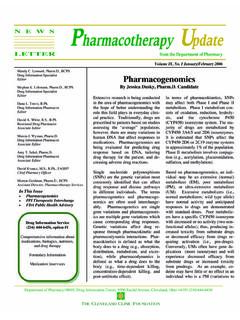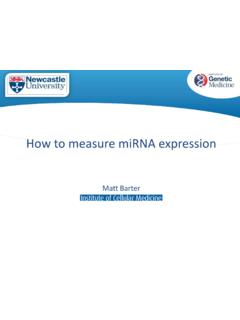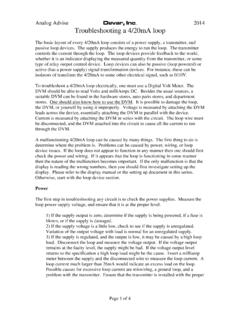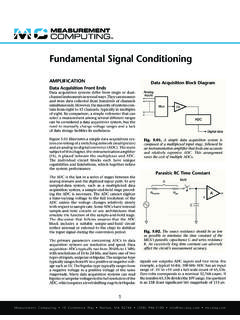Transcription of Interpretation of Common LungInterpretation of …
1 1 Interpretation of Common LungInterpretation of Common Lung Function TestsRaed A. Dweik, , FRCP(C), FCCP, FCCM, FAHAD irector Pulmonary Vascular ProgramDOS CME Course 20111 Oxtober 20101 ConfidentialDirector, Pulmonary Vascular ProgramPulmonary, Allergy, and Critical Care MedicineRespiratory Institute Cleveland Clinic 2011 Lung (pulmonary) function tests (PFTs) Spirometry Before and after bronchodilator Sitting and supine Lung volumesg Diffusion capacity (DLCO) Methacholine challenge Maximum voluntary ventilation (MVV) Maximum inspiratory and expiratory pressures (MIPS/MEPS) Pulse oximetry Arterial blood gases (ABGs) Arterial blood gases (ABGs)
2 Six minute walk test Cardiopulmonary exercise test (CPET) Exhaled nitric oxide (FENO)2 DOS CME Course 20112 Spirometry3 DOS CME Course 2011 Pulmonary function testing equipment4 DOS CME Course 20113 Lung Volumes (4) and Capacities (4)5 DOS CME Course 20116 DOS CME Course 20114 Body Box7 DOS CME Course 2011 Flow Volume Loop8 DOS CME Course 201159 DOS CME Course 2011 PFT Interpretation : Flow Volume loop10 DOS CME Course 2011106A 68 year old male for pre-op evaluationNormal SpirometryNormal Lung VolumesNormal DLCO11 DOS CME Course 2011 Spirometry Important Parameters FVC: maximum amount of air exhaled after a maximal inhalation If normal: Elasticity is fairly normal (normal lung tissue) Thoracic cage (configuration of thoracic spine/ribs) is normal Respiratory muscles aren t too weakpy If low, suggests one or more of the above is a problem (restrictive disorder) FEV1: amount of air exhaled in the first second as forcefully as possible from a full lung Measuring the speed of the air being exhaled can provide a window to the airways volume exhaled in the first second is a measure of speed (liters/second) (FEV1)(FEV1) reduced speed indicates obstructed or narrowed airways FEV1/FVC ratio.
3 Identification of airflow obstruction: <70% of predicted LLN12 DOS CME Course 2011713 DOS CME Course 2011 Lung Function, What s Normal? Gender, Age, Height, Race Test data collected on a large number of normal individuals No history of lung disease No symptoms Normal chest X-ray Normal EKG Pooled data used to relate lung function to characteristics most closely related to lung function Predicted value (% of predicted): Age and height are entered into an equation to calculate the average predicted valuefor an individual = middle of the normal range Lower limit of normal (LLN): Another equation is used to define the Lower Limit of Normal = lowest value considered normal for an individual14 DOS CME Course 20118 Racial Adjustment of Predicted Value Most studies for normal values in US looked at Caucasian populations of normals Not appropriate for other ethnic groupspp pgp If used in African-American population, more likely to seem abnormal (12% higher) Controversial.
4 Adjustment of predicted value downward reduces the sensitivity of the test for detecting abnormality NHANES predicted set for spirometry Comparing individual to him/herself increases sensitivity of the test to detect changes15 DOS CME Course 2011 PFT Interpretation : step by step Step 1: FEV1/FVC ratio FEV1/FVC <70% (or less than the LLN): Obstructive pattern (COPD, asthma) 70%: Normal or Restrictive disease Step 2: Severity of obstruction (GOLD Criteria for COPD) Severity of obstruction (GOLD Criteria for COPD) FEV1 80 - 100% predicted: Mild (Stage I) FEV1 50 - <80% predicted: Moderate (Stage II) FEV1 30 -<50% predicted: Severe (Stage III) FEV1 < 30% predicted: Very severe (Stage IV) FEV1< 50% with right side heart failure: Very severe (Stage IV) Severity of obstruction (ATS General Criteria): keep it simple FEV1 over 70% predicted: MILD FEV1 60-70% predicted: MODERATE FEV1 50-60% predicted: MODERATELY SEVEREFEV1 3550% predicted:SEVERE FEV1 35-50% predicted: SEVERE FEV1 < 35% predicted: VERY SEVERE Step 3: Bronchodilator response.
5 12% increase ANDan absolute improvement of at least 200 ml after inhaling a beta agonist FEV1, ORFVC is considered a significant response 16 DOS CME Course 20119 PFT Interpretation : step by step Step 4: Total Lung Capacity (TLC) (Normal range: 80 - 120% of predicted) TLC > 120 = Hyperinflation TLC < 80% = Restrictive disease (ATS criteria for severity): keep it simple 70-80 % predicted: mild6070%di t ddt 60-70% predicted: moderate 50-60% predicted: moderately severe < 50% predicted: severe Step 5: RV/TLC ratio (Normal range: < 35% or < predicted) RV/TLC > 35% or > predicted indicates Air trapping Step 6: DLCO (Normal range: 80- 120% of predicted) In obstructive disease: Decreased in Emphysemapy Normal in chronic bronchitis Normal or increased in Asthma In restrictive disease: Decreased in parenchymal disease Normal in non-parenchymal ( chest wall) restriction17 DOS CME Course 2011 FEV1/FVC < LLN?
6 Restrictive or normalObstructive patternQuantitate obstruction using FEV1 % of predictedNoYesRapid Interpretation of Pulmonary Function TestsFVC < LLN?us g%o p ed ctedFVC < LLN?Normal spirometryRestrictive patternPure obstructionTLC known?TLC known?TLC < LLN?Quantitate restriction using FVC % of predictedPossible mixed obstruction and restriction or pure obstruction withTLC < LLN?NoYesYesNoYesNoYesNo18 DOS CME Course 2011 Quantitate restriction using TLC % of predictedNormal testobstruction with pseudorestrictionPure obstruction with pseudorestrictionMixed obstruction and restrictionNoYesYesNo1810 Measure Obstructive Disorders Restrictive Disorders Mixed Disorders FEV1/FVCD ecreasedNormal or increasedDecreasedFEV1 DecreasedDecreased, normal, or increasedDecreasedFVCD ecreased or normalDecreasedDecreased or normalPFT Interpretation .
7 Disease PatternsTLCN ormal or increasedDecreasedDecreased, normal, or increasedRVNormal or increasedDecreasedDecreased, normal, or increased19 DOS CME Course 2011 DLCO Diffusing Capacity of the Lung for Carbon Monoxide (CO) Measures the efficiency of the gas transfer characteristics of the lungs20 DOS CME Course 201111A 39-yr-old male: pre-op evalualtionNormal FEV1/FVC ratio Normal FVCN ormal FEV1 Normal Spirometry21 DOS CME Course 2011A 21-yr-old female with cough and wheezingReduced FEV1/FVC ratio =obstructionReduced FEV1 Reduced FEV1 Normal FVC = pure obstructionSignificant Bronchodilator responseReversible airway obstruction.
8 Asthma22 DOS CME Course 201112A 69-yr-old male with chronic cough and progressive SOBN ormal FEV1/FVC ratioReduced FVC, Reduced FEV1 Reduced TLCR educed DLCO23 DOS CME Course 2011A 58-yr-old female with chest painNormal FEV1/FVC ratio Normal FVCN ormal FEV1 Normal Spirometry24 DOS CME Course 201113A 65-yr-old female with shortness of breathNormal SpirometryNormal Lung VolumesReduced DCLO: isolated25 DOS CME Course 2011 Common Spirometry Patterns Normal: normal spirometry (normal FVC, FEV1/FVC ratio) Obstruction to airflow: normal FVC + low FEV1 = low FEV1/FVC%; assess BD response Restrictive changes: low FVC + Low FEV1 =normal FEV1/FVC%: consider get lung volumes and DLCO Combined obstructive and restrictive: low FVC, low FEV1, and low FEV1/FVC%: consider lung volumes and DLCO26 DOS CME Course 201114 PFTs: Methacholine Challenge27 DOS CME Course 2011 Key take home points The term pulmonary function test (PFT) can mean many different things Spirometry is the most commonly performed PFT Focus on 3 parameters: FVC, FEV1 and FEV1/FVC ratio Following a simple preset algorithm, and Common spirometry patterns, gpp g ,p yp ,one can determine the presence of: Obstruction.
9 COPD, Asthma, etc Restriction: ILD (IPF and others), chest wall disease, etc Mixed disorders: sarcoidosis, cystic fibrosis, COPD+ILD, etcLowLowNML or lowFVC (L)CombinedRestrictiveObstructiveLowLowN ML or lowFVC (L)CombinedRestrictiveObstructiveLowNorm al or ElevatedLowFEV1/FVC (%)LowerLowLowFEV1(L)(L)LowNormal or ElevatedLowFEV1/FVC (%)LowerLowLowFEV1(L)(L)28 DOS CME Course 201115 CME Course 2011 DOS CME Course 20113030 DOS CME Course 201130 DOS CME Course 2011


